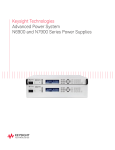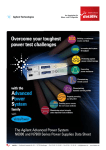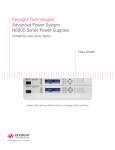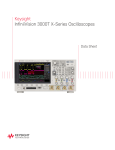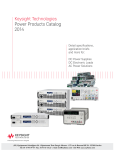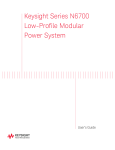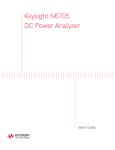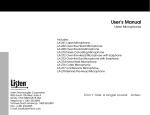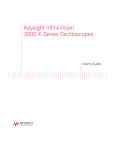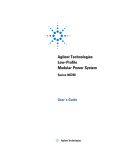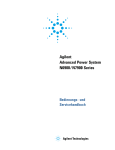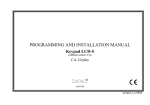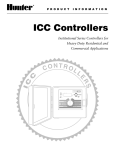Download Advanced Power System N6900 and N7900 Series
Transcript
Keysight Technologies Advanced Power System N6900 and N7900 Series Power Supplies Advanced Power System (APS) Overview Overcome your power test challenges with the Advanced Power System family Get lots of power in a small test-system footprint With the Keysight Technologies, Inc. Advanced Power System (APS) 1 kW and 2 kW system power supplies, you get a new level of power supply performance. The Advanced Power System (APS) family was designed with VersaPower architecture to help you overcome your toughest p ower test challenges by delivering industry-leading specifications and innovative features in an integrated solution for today’s advanced ATE power testing needs. Two power ranges deliver a large amount of power in a small test-system footprint: – 1 kW models have a 1U full-rack footprint – 2 kW models have a 2U full-rack footprint – Built-in paralleling capability up to 10kW VersaPower architecture delivers the fastest, most accurate, integrated power system – Accelerate test-system throughput with industry-leading speed 1000 W in 1U – Capture your DUT’s current proile with accurate measurements – Reduce your ATE development time and cost with highly integrated capabilities 2000 W in 2U Choose the right APS performance class to meet your needs Keysight N6900 Series DC power supplies Designed for ATE applications where high performance is critical Keysight N7900 Series dynamic DC power supplies Designed for ATE applications where high-speed dynamic sourcing and measurement is needed Choose the APS model with the voltage and current you need Both the N6900 Series DC power supplies and the N7900 Series dynamic DC power supplies provide five voltage and current combinations at the 1 kW power range and seven voltage and current combinations at the 2 kW power range. Keysight N6900 Series DC power supplies Keysight N7900 Series dynamic DC power supplies 1 kW models 2 kW models 1 kW models 2 kW models N6950A 9V, 100A N6970A 9V, 200A N7950A 9V, 100A N7970A 9V, 200A N6951A 20V, 50A N6971A 20V, 100A N7951A 20V, 50A N7971A 20V, 100A N6952A 40V, 25A N6972A 40V, 50A N7952A 40V, 25A N7972A 40V, 50A N6953A 60V, 16.7A N6973A 60V, 33A N7953A 60V, 16.7A N7973A 60V, 33A N6954A 80V, 12.5A N6974A 80V, 25A N7954A 80V, 12.5A N7974A 80V, 25A N6976A 120V, 16.7A N7976A 120V, 16.7A N6977A 160V, 12.5A N7977A 160V, 12.5A 2 Test challenges and how the APS helps you overcome them The APS, with Keysight’s exclusive VersaPower architecture, helps you overcome a wide variety of power test challenges. Power related test challenge How the APS helps you overcome the challenge Increasing test system throughput: Reducing test time can mean big savings, so achieving throughput gains is a never-ending quest. Building a continuous source and load: You need a continuous source and load solution for testing power storage DUTs. Protecting against power related damage: When testing expensive DUTs, designing protection from power damage in the test system is critical. Characterizing dynamic current proiles: Your DUT has a current proile with a large dynamic range that you need to characterize. – Fast up and down programming speeds (up to 500 µs) – Fast command processing (< 2 ms) – List capability to step through a list of voltage or current levels – Seamless ranging capability for fast current measurements without sacriicing accuracy – Full two-quadrant glitch-free operation across quadrants – Voltage and current limit settings to keep your device within its operating range – – – – Smart triggering Fast output response Output disconnect relays Watchdog timer – – – – 18-bit high resolution current digitizer Adjustable measurement sample rate External logging capability Peak triggering and measurements Generating power transients: In harsh real-world environments, DUTs can face power transients, such as surges and interrupts. To ensure proper operation of a design in the real world, these transients need to be simulated in testing. Characterizing inrush current: You need to capture the large current surge that occurs when you irst turn on power to your DUT with reactive elements at the input. Maintaining output integrity under dynamic load conditions: Maintaining a stable output voltage free of oscillations and voltage droop can be a challenge under a very dynamic load, especially when working with long cable runs. Tracking power events for root-cause analysis: You want to track power events during root-cause analysis testing to see why or if you’re DUT was damaged during test. Properly powering on/off a DUT: To prevent damage at turn-on or turn-off, you need to properly sequence multiple supplies on/off or tune their slew rates. 3 – AWG capability – Step function capability – High bandwidth mode – High resolution current and voltage digitizers – Pre- and post-triggering for capturing measurement data – Large current range that is over 2x the rated output of the power supply – Fast transient response to ensure minimal voltage droop to load transients – High and low output bandwidth settings for tuning the output to your load – Built-in Black Box Recorder – Records voltage, current, power, trigger events, mode changes, and more in non-volatile memory – Sequencing capability across multiple APS supplies – Sequencing capability with Keysight’s N6700 modular power supply family – Adjustable slew rate control A Deeper Look at How the APS Can Help You Overcome Your Power Test Challenges – Accurately capture dynamic current proiles: APS has two current measurement ranges that allow it to measure micro-amps to amps. The APS uses seamless ranging technology to transition from one measurement range to the other without discontinuities in the output power or in measurement data (see Figure 1). Accelerate test throughput with industry-leading specifications Shaving seconds or even milliseconds off a test time can lead to significant savings for high-volume manufacturers, making throughput gains a never-ending quest for test system designers. The APS is a valuable tool for increasing throughput. It provides a number of industry-leading specifications and innovative features that can help you achieve significant throughput gains in your testing. Some examples: 25 Current 20 – Industry-leading command processing time (<2 ms) 15 10 5 – Fast up and down programming speeds (up to 500 µs) 0 0 – Adjustable measurement times for optimum measurements in minimum time 1 2 3 4 5 Time in seconds Current – Seamless ranging capability for fast current measurements without sacriicing accuracy – Output lists that allow you to step through timed or triggered voltage or current levels that can also generate triggers for tightly synchronized measurements 0.05 0 2.2 Accurately characterize your DUT’s power profile with advanced measurements 2.4 2.6 2.8 3 3.2 3.4 3.6 3.8 Time in seconds Figure 1. Dynamic current measurement – Accurately measure power storage and eficiency: In addition to high-accuracy voltage and current measurement capabilities, APS power supplies offer built-in power, peak power, amp-hour, and watt-hour calculations. These measurements help simplify your power eficiency and storage calculations. The APS provides simultaneous voltage and current measurement capabilities that deliver high accuracy and resolution. Make measurements using two main modes: averaged or digitized. In average mode, the APS delivers highaccuracy DMM-quality voltage and current measurements. The digitizing capability allows you to capture dynamic current or voltage profiles at much higher resolution than an oscilloscope. – Additional APS measurement capabilities: – Adjustable measurement intervals for both average and digitized measurements – Capture inrush current: APS provides an 18-bit current digitizer with a sample rate up to 200 kS/s, level triggers, and a current measurement range that is 2.25x higher than the max output current range of the power supply. – External logging capability, which simpliies data logging in ATE software – Pre-, post-, and level triggering for pinpointing exactly where and when to measure 4 Reduce ATE development time and support costs with integrated features To compliment the two quadrant operation, all APS power supplies have built-in programmable output resistance capability. This capability allows an APS power supply to simulate the internal resistance of a battery. Continuously source and sink current for power storage test applications Smart triggering: Increase throughput, protect your DUT, and reduce test complexity When operated as standalone units, APS power supplies can continuously sink up to 10% of their rated output current for an indefinite time. With the addition of APS N7909A power dissipater units, APS power supplies can continuously sink up to 100% of their rated output current. This means you can sink the power supply’s full rated output power for an indefinite time. Note that the two-quadrant sourcing and sinking capability of the DC power supply allows for continuous transitions between sourcing and sinking current without changing the power supply’s output characteristics or introducing any disruptive behavior. These capabilities make the APS an ideal solution for continuous source and sink testing needs in power storage applications. For more information on the APS N7909A, see page 8. The APS’s smart triggering system provides trigger capabilities never before seen in a power supply. The APS’s smart triggering can accelerate your test throughput, better protect your DUT, and reduce the complexity of your test system. The smart triggering system includes all the basic triggering functionality you would expect in a system power supply, but it goes well beyond with capabilities such as: – Level triggering allows you to execute a trigger from ive different APS measurement parameters: voltage, current, power, amp-hour, and watt-hour. +V E-Load DC Source Quadrant Quadrant – Logical triggering gives you the ability to create logical “and,” “or,” and “not” trigger expressions using various trigger conditions such as digital input pins, level triggers, status bits, and more. +A -A 100% – Triggers can be used to transition through a list of voltage or current levels as well as through the points of a voltage or current waveform. 10% – Triggers with precision delays can be sent out from the APS after a voltage or current level change/transient. These triggers can be used to signal another instrument in the test system to do something after a voltage or current change. Figure 2. When you add N7909A power dissipater units to an APS supply, you extend its ability to sink current from 10% to 100% of its rated current Figure 3 shows an example of an APS power supply smoothly pulsing back and forth from sinking current at -10 A to sourcing current at 10 A. Notice that the voltage level captured at high resolution on the top trace remains constant with no glitches. Track power events with a black box recorder If you are testing expensive prototypes and a power-related problem damages or destroys your DUT, you need to figure out what went wrong to ensure it does not happen again. The APS’s optional N7908A black box recorder (BBR) overcomes this test challenge by creating a power event record inside the power supply. Much like an airplane flight data recorder, the APS black box recorder is always recording events. When the power supply is on, it is always running, recording power events and making measurements in non-volatile memory regardless of what the power supply is doing or how it is being used. Figure 3. 5 Examples of what it records: Generate voltage and current transients – Voltage (min, max, and avg), current (min, max, and avg), and power (min, max, and avg) – Trigger events – Status bits DUTs that are operated in rugged environments, such as automotive electronics and avionics, can often experience transient behavior from the power source, such as voltage dropouts or surges. To ensure your DUT can stand up to these real-world transients, you must simulate worst-case power transient conditions in the test process. The APS power supplies provide three different functionalities for simulating either voltage or current transients for testing: – Front panel and command events – User deined tags See page 8 for more information on the APS N7908A BBR. Avoid damage to your DUT with APS protection Step: One-time event that steps the output voltage or current up or down in response to a triggered event. Arbitrary waveforms: An arbitrary waveform generator (arb) allows you to generate complex user-defined voltage or current waveforms of up to 65,535 data points. When you are testing costly DUTs, integrating power protection measures into the test system is critical. Using instrumentation with built-in protection features provides a huge benefit when DUT protection is required. Here’s why: List: A list can consist of up to 512 steps. Each step in the list can have a unique dwell time associated with it, which specifies the time in seconds that the list will remain at that step before moving on to the next step. Lists can also be trigger-paced, in which case the list advances one step for each trigger received. – Built-in protection features, such as broken sense line detection, reduce the amount of protection hardware needed in the test system reducing complexity and development time. For a demonstration of the APS’s arb capability an example “interrupt” pulse was generated with the N7951A into a resistive load. The interrupt pulse goes from 20 V to 2 V for 10 ms and then returns to 20 V. The resulting interrupt pulse was captured (Figure 4) and its fall time was measured to be < 200 us (Figure 5). For more information on the APS’s output bandwidth and speed for generating voltage and current transients, refer to the specifications section in this document or the APS user manual. – With protection features integrated into the instrumentation, the amount of hardware needed for the test system is reduced, which in turn lowers test system support costs. – With protection measures implemented in hardware rather than test system software, error conditions can be detected and handled much faster, reducing the likelihood of the DUT sustaining major damage. The APS power supplies feature advanced and fast protection capabilities fully integrated. These protection capabilities include: 10 ms pulse width – Fast CC/CV mode crossover as well as user-settable voltage and current priority modes to reduce unwanted voltage or current overshoots – Smart triggering – Over- and under-voltage and current protection – Fast reaction to error conditions – Output disconnect relays – User-conigurable watchdog timer – Broken and shorted sense line detection Figure 4. Voltage interrupt pulse generated by N7951A 6 Add power lexibility to your test system by paralleling multiple APS supplies Paralleling multiple power supplies together is a great way to add power flexibility to your test system. The down side of paralleling power supplies together is typically you cannot get all the supplies to operate in the desired constant voltage (CV) or constant current (CC) mode. For instance, when trying to operate in CV mode with two parallel supplies, one will typically source the bulk of the current and operate in CC mode and the other supply will source only a fraction of the current and operate in CV mode. This condition can highly degrade certain power supply performance specifications such as transient response. fall time: 184 µs With the APS you do not have to worry about this since it has built-in paralleling capability that ensures each supply equally shares the load current so they all remain in the desired mode, whether it is CV or CC. Note that paralleling works whether the APS power supplies are sourcing or sinking current from the DUT. Figure 5. Interrupt pulse fall time measurement of < 200 us Properly powering on and off your DUT with the APS To take advantage of the APS paralleling capability, you need only a simple three-wire connection in the rear of the supplies in the parallel configuration (see Figure 6). With this capability, you can parallel up to five APS power supplies (recommended), which provides a max power of 10 kW. If you work with DUTs that have multiple power supply inputs, such as satellite payloads, you often need to properly sequence on or off each power supply at strict repeatable times to prevent current surges and latch-up conditions. In addition to sequencing on or off each supply, you may need to set the ramp rate of each supply at turn-on or turn-off to a particular rate. These requirements add significant complexity to an ATE test system, both in hardware and software. The APS power supplies can help you overcome this test challenge by providing built-in sequencing capability across APS mainframes or with Keysight’s popular N6700 family of modular system power supplies. Also, the APS power supplies provide adjustable slew rate control at turn-on or turn-off. These built-in capabilities provide a clean low-complexity way to properly power-on or off your DUT during test. Figure 6. An APS supply’s three-wire connection for paralleling multiple supplies For more information on how the APS can help you overcome your power-related test challenges, including videos, application notes, and example code, visit www.keysight.com/find/TestChallenges. 7 – By default, the APS’s current sink capability will perform down programming for pulling down voltage levels when it is connected to loads with stored energy, for instance loads with a large amount of parallel capacitance at their input. APS Hardware Accessories and Software – All these capabilities are also available when you use a standalone APS power supply’s 10% rated output current sinking capability without the N7909A power dissipater unit. Note: Even though the APS’s two-quadrant operation gives it much of the same functionality as a DC electronic load, it cannot simulate current transients as fast as an electronic load. For instance, the APS can simulate full range -/+ current transients at ~ 5 ms, where a high-performance electronic load can achieve current transients < 1 ms. See the specifications and user guide at for more information at APS N7909A power dissipater unit The optional N7909A power dissipater unit adds current sinking or two-quadrant operation to any N6900 or N7900 power supply. Each N7909A provides up to 1 kW of current sinking capability to an APS power supply, so you will need two N7909As to achieve full two-quadrant operation of a 2 kW APS supply. You can use a single N7909A with a 2 kW APS power supply to achieve 50% current sinking capability. The N7909A form factor is 1U and full rack width. N7909A connects to an APS power supply via a two-wire power connection and a communication connection to provide continuous two-quadrant operation. The connections are located on the rear panel of both the N7909A and the supply, as shown in Figure 7. www.keysight.com/find/APS-doc APS N7908A black box recorder Much like a flight data recorder, the N7908A black box recorder (BBR) runs continually in the background, independent of what the power supply is doing. When the power supply is on, the BBR is recording power events and storing measurements in non-volatile memory. The BBR can be set for either a 24hour record or a 10-day record period. In the 24-hour mode, measurements are made at a rate of 100 per second, and in the 10-day mode they are made at a rate of 10 per second. The BBR data can be accessed via the free APS power assistant software (see Figure 9 on page 9). The BBR is a user-installable hardware option, and it works in all APS N6900 and N7900 power supplies. You can purchase the N7908A BBR with an APS power supply or buy it later and install it in your existing APS power supply. The BBR hardware board plugs into the bottom of an APS power supply, as shown in Figure 8. Figure 7. N7909A power dissipater unit rear connections to a 1 kW APS power supply The N7909A does not operate as a standalone instrument. It only works with an APS power supply. Additional information on the APS’s 2-quadrant operation: – The APS provides programmable ± current waveform capability to fully utilize the two-quadrant operation – The APS provides ± current limit settings to ensure your device is operated in its allowable range Figure 8. Installing the N7908A BBR hardware option on an APS power supply 8 APS N7907A rack mount kit The N7907A rack mount kit can be used for all N6900 and N7900 power supplies, regardless if they are 1 kW or 2 kW form factors. It can also be used for mounting the N7909A. N7907A APS rack mount kit is needed for every APS power supply or N7909A dissipater that you would like to mount. The N7907A is intended for use in a 19-inch EIA rack cabinet. APS power supplies and power dissipater units can be mounted directly above or below each other without any worry of heat problems. For installation instructions and other rack-mounting options, refer to the APS user manual at www.keysight.com/find/APS-doc. N7906A power assistant software The APS N7906A power assistant software is a free application that works with the APS power supplies. The power assistant software provides three main capabilities for working with the APS power supplies: – Control an APS power supply using the Power assistant software’s intuitive graphical user interface – Retrieve and view data from the optional APS power supply black box recorder (see Figure 9) – Perform trigger routing and conigure logical trigger expressions (see Figure 10) Figure 9. Black box recorder data displayed within the N7906A Power Assistant software The power assistant software is available for download at www.keysight.com/find/powerassistant. For more information on the APS power assistant software, refer to the APS user manual at www.keysight.com/find/APS-doc. Threshold Protect > 24.5V Routing Custom OR User Selection Threshold Event1 Event1 < 23.5V Event2 Figure 10. Configuring a trigger expression with the N7906A Power Assistant software 9 Differences Between the APS N6900 Series and N7900 Series Table 3. This table compares performance specifications and features of the N6900 DC Series power supplies and the N7900 Series dynamic DC power supplies. Feature N6900 1 kW and 2 kW models N7900 1 kW and 2 kW models Voltage and current programming 14-bit precision 16-bit precision 18-bit precision 18-bit precision 3 ms / 3 ms 0.5 ms / .35 ms 100 us 100 us Two-quadrant operation (10% standard, 100% optional) Yes Yes Smart triggering Yes Yes Power storage and eficiency measurements Yes Yes Output sequencing / adjustable slew rate Yes Yes Parallel operation Yes Yes Low current measurement range No Yes Seamless current measurements No Yes V and I digitizers with programmable sample rates No Yes External logging capability No Yes Output list capability No Yes Arbitrary waveform generation No Yes Output relays (disconnect and polarity reversal) No Yes2 Voltage and current measurements 1 Voltage up / down programming time Transient response time (recovery time)1 1. For detailed speciications, see APS user manual. 2. N7950A and N7970A only have output disconnect relays, no polarity reversal relays. 10 APS Specifications For more detailed specifications refer to the APS user manual at www.keysight.com/find/APS-doc. N6900 speciications 1 kW / 2 kW Table 4. DC ratings Voltage range Current max Current sink @10% Current sink @100%1 Power Output ripple & noise2 CV rms CV peak-to-peak Load regulation Voltage Current Volt programming & meas. accuracy3 Lead drop ≤1 V max Lead drop ≤25% of V rating N6950A / 70A N6951A / 71A N6952A / 72A N6953A / 73A N6954A / 74A N6976A N6977A 0 to 9 V 100 A / 200 A -10 A / -20 A -100 A / -200 A 900 W / 1.8 kW 0 to 20 V 50 A / 100 A -5 A / -10 A -50 A / -100 A 1 kW / 2 kW 0 to 40 V 25 A / 50 A -2.5 A / -5 A -25 A / -50 A 1 kW / 2 kW 0 to 60 V 16.7 A / 33.3 A -1.67 A / -3.33A -16.7 A / -33.3 A 1 kW / 2 kW 0 to 80 V 12.5 A / 25 A -1.25 A / -2.5 A -12.5 A / -25 A 1 kW / 2 kW 0 to 120 V 16.7 A -1.67 A -16.7 A 2 kW 0 to 160 V 12.5 A -1.25 A -12.5 A 2 kW 1 mV 9 mV 1 mV 9 mV 1 mV 9 mV 1 mV 9 mV 1 mV 9 mV 2 mV 30 mV 3 mV 30 mV 0.5 mV 8 mA / 15 mA 0.75 mV 3 mA / 6 mA 1.5 mV 1 mA / 2 mA 4 mV 1 mA 4 mV 0.8 mA 0.03% +24 mV 0.03% +32 mV 2 mV 2 mV 1 mA / 1.5 mA 0.8 mA / 1.5 mA 0.03% +1.5 mV 0.03% +1.9 mV 0.03% +3 mV 0.03% +4 mV 0.03% +6 mV 0.03% +7.9 mV 0.03% +9 mV 0.03% +12 mV 0.03% +12 mV 0.03% +16 mV 0.03% +17 mV 0.03% +23 mV Curr programming & meas. accuracy3 0.1% +30 / 60 mA 0.1% +15 / 30 mA 0.1% +8 / 15 mA 0.1% +5 / 10 mA 0.1% +4 / 8 mA 0.1% +5 mA 0.1% +4 mA Transient response4 Recovery time Settling band 100 us 150 mV 100 us 150 mV 100 us 100 mV 100 us 150 mV 100 us 200 mV 100 us 300 mV 100 us 400 mV Volt up & down programming time6 10% to 90% and 90% to 10% Settling time 3 ms 10 ms 3 ms 10 ms 3 ms 10 ms 3 ms 10 ms 3 ms 10 ms 3 ms 10 ms 3 ms 10 ms Curr. up-programming time6 10% to 90% 2.5 ms 2.5 ms 2.5 ms 2.5 ms 2.5 ms 2.5 ms 2.5 ms Resistance programming6 Range Accuracy Resolution 0 to 0.1 / 0.05 Ω 0.12% +1.6 mΩ*A 0.8 μΩ / 0.4 μΩ 0 to 0.4 / 0.2 Ω 0.12% +3.2 mΩ*A 3.4 μΩ / 1.7 μΩ 0 to 1.6 / 0.8 Ω 0.12% +6.4 mΩ*A 13 μΩ / 7 μΩ 0 to 3.4 / 1.7 Ω 0.12% +8.8 mΩ*A 30 μΩ / 15 μΩ 0 to 6.4 / 3.2 Ω 0.12% +12.8 mΩ*A 54 μΩ / 27 μΩ 0 to 6.8 Ω 0.12% +17.7 mΩ*A 60 μΩ 0 to 12.8 Ω 0.12% +25.6 mΩ*A 108 μΩ N7900 speciications 1 kW / 2 kW Table 5. (continued on next page) N7950A / 70A N7951A / 71A N7952A / 72A N7953A / 73A N7954A / 74A N7976A N7977A DC ratings Voltage range 0 to 9 V Current max 100 A / 200 A Current sink @10% -10 A / -20 A Current sink @100%1 -100 A / -200 A Power 900 W / 1.8 kW 0 to 20 V 50 A / 100 A -5 A / -10 A -50 A / -100 A 1 kW / 2 kW 0 to 40 V 25 A / 50 A -2.5 A / -5 A -25 A / -50 A 1 kW / 2 kW 0 to 60 V 16.7 A / 33.3 A -1.67 A / -3.33 A -16.7 A / -33.3 A 1 kW / 2 kW 0 to 80 V 12.5 A / 25 A -1.25 A / -2.5 A -12.5 A / -25 A 1 kW / 2 kW 0 to 120 V 16.7 A -1.67 A -16.7 A 2 kW 0 to 160 V 12.5 A -1.25 A -12.5 A 2 kW 11 N7900 speciications 1 kW / 2 kW (Continued) Table 5 Output ripple & noise2 CV rms CV peak-to-peak N7950A / 70A N7951A / 71A N7952A / 72A N7953A / 73A N7954A / 74A N7976A N7977A 1 mV 9 mV 1 mV 9 mV 1 mV 9 mV 1 mV 9 mV 1 mV 9 mV 2 mV 30 mV 3 mV 30 mV 0.75 mV 3 mA / 6 mA 1.5 mV 1 mA / 2 mA 4 mV 1 mA w4 mV 0.8 mA Load regulation 0.5 mV Voltage Current 8 mA / 15 mA 2 mV 2 mV 1 mA / 1.5 mA 0.8 mA / 1.5 mA Volt programming and measurement accuracy3 Lead drop ≤1 V max 0.03% +1 mV Lead drop ≤25% of V rating 0.03% +1.4 mV 0.03% +2 mV 0.03% +3 mV 0.03% +4 mV 0.03% +6 mV 0.03% +5.9 mV 0.03% +9 mV 0.03% +8 mV 0.03% +11 mV 0.03% +12 mV 0.03% +17 mV Curr. programming and measurement accuracy3 0.04%+15/30mA 0.04% +8 / 15 mA 0.04% +4 / 8 mA 0.04%+2.5/5mA 0.04% +2 / 4 mA Current measurement low-range accuracy3 0.05% +3/6 mA 0.05% +1/2 mA 0.05% +0.6/1.2 mA 0.05% +0.3/0.6 mA 0.05%+0.25/0.5mA 0.05% +0.4 mA 0.05% +0.25 mA Curr. Measurement ranges5 High range N795x -225 A to 225 A High range N797x -450 A to 450 A Low range N795x -11 A to 11 A Low range N797x -22 A to 22 A -112.5 A to 112.5 A -225 A to 225 A -5.5 A to 5.5 A -11 A to 11 A -56.2 A to 56.2 A -112.5 A to 112.5A -2.75 A to 2.75 A -5.5 A to 5.5 A -37.6 A to 37.6 A -74.9 A to -74.9 A -1.84 A to 1.84 A -3.67 A to 3.67 A -28.1 A to 28.1 A -56.2 A to 56.2 A -1.37 A to 1.37 A -2.75 A to 2.75 A N/A -37.6 A to 37.6 A N/A -1.84 A to 1.84 A N/A -28.1 A to 28.1 A N/A -1.37 A to 1.37 A 100 us 150 mV 100 us 100 mV 100 us 150 mV 100 us 200 mV 100 us 300 mV 100 us 400 mV Volt up programming time6 10% to 90% 0.5 ms Settling time 1 ms 0.5 ms 1 ms 0.5 ms 1 ms 0.5 ms 1 ms 0.5 ms 1 ms 0.5 ms 1 ms 0.5 ms 1 ms Volt down programming time6 90% to 10% 0.35 ms Settling time 0.8 ms 0.35 ms 0.8 ms 0.35 ms 0.8 ms 0.35 ms 0.8 ms 0.35 ms 0.8 ms 0.35 ms 0.8 ms 0.35 ms 0.8 ms Voltage programming bandwidth (no load)6 -3 dB point 2 kHz -1 dB point 1 kHz 2 kHz 1 kHz 2 kHz 1 kHz 2 kHz 1 kHz 2 kHz 1 kHz 2 kHz 1 kHz 2 kHz 1 kHz Curr. up-programming time6 10% to 90% 2.5 ms 2.5 ms 2.5 ms 2.5 ms 2.5 ms 2.5 ms 2.5 ms Current programming bandwidth (resistive load)6 -3 dB point 160 Hz -1 dB point 70 Hz 160 Hz 70 Hz 160 Hz 70 Hz 160 Hz 70 Hz 160 Hz 70 Hz 160 Hz 70 Hz 160 Hz 70 Hz Transient response4 Recovery time 100 us Settling and 150 mV 0.04% +2.5 mA 0.03% +14 mV 0.03% +22 mV 0.04% +2 mA Resistance programming6 0 to 12.8 Ω Range 0 to 0.1 / 0.05 Ω 0 to 0.4 / 0.2 Ω 0 to 1.6 / 0.8 Ω 0 to 3.4 / 1.7 Ω 0 to 6.4 / 3.2 Ω 0 to 6.8 Ω Accuracy 0.06% +1.6 mΩ*A 0.06% +3.2 mΩ*A 0.06% +6.4 mΩ*A 0.06% +8.8 mΩ*A 0.06% +12.8 mΩ*A 0.12% +17.7 mΩ*A 0.06% +25.6 mΩ*A 30 μΩ / 15 μΩ 54 μΩ / 27 μΩ 60 μΩ 108 μΩ Resolution 0.8 μΩ / 0.4 μΩ 3.4 μΩ / 1.7 μΩ 13 μΩ / 7 μΩ 1. Current sinking up to 100% of rated current requires one N7909A power dissipater for 1 kW models and two N7909A power dissipaters for 2 kW models. 2 kW models with one power dissipater can sink 50% of their rated current. 2. From 20 Hz to 20 MHz. 3. Expressed as % of setting (or % of measurement) + offset. At 23 °C ±5 °C after a 30-minute warm-up; measurement. NPLC=1; valid for 1 year. 12 4. Time to recover within the settling band following a load change from 50% to 100% of full load. 5. When sinking current, the negative current measurement ranges match the positive current measurement ranges. 6. These are supplemental characteristics Two-quadrant speciications + Voltage rating V1 V2 0 – Current rating + Current rating Key Sourcing power Sinking power up to 10% of rating (without dissipater) Sinking power up to 100% of rating (with dissipater) Table 6. N6950A/70A N7950A/70A N6951A/71A N7951A/71A N6952A/72A N7952A/72A N6953A/73A N7953A/73A N6954A/74A N7954A/74A N6976A N7976A N6977A N7977A + Voltage rating 9V 20 V 40 V 60 V 80 V 120 V 160 V +Current rating 100 A/200 A 50 A/100 A 25 A/50 A 16.7 A/33.3 A 12.5 A/25 A 16.7 A 12.5 A -50 A/-100 A -25 A/-50 A -16.7 A/-33.3 A -12.5 A/-25 A -16.7 A -12.5 A -Curr rating (w/dissipater) -100 A/-200 A V1 0.68 V 0.525 V 1.9 V 1.47 V 2.0 V 3V 4V V2 0.068 V 0.0525 V .19 V .147 V 0.2 V 0.3 V 0.4 V 13 APS digital control port APS General Information On the rear panel of every APS power supply is a digital control port that consists of seven I/O pins that provide access to various control functions, as shown in Figure 11. Each pin is user configurable. Table 7 describes the possible pin configuration for the digital port functions. APS N6900 Series and N7900 Series power supply power requirements Connect the power cord that was supplied with your unit to the AC mains connector on the rear of the unit. Note that these cords are standard and are specially rated to handle the power needs of the APS supply they are shipped with. The AC input on the back of your unit is a universal AC input. It accepts nominal line voltages in the range of 100 VAC to 240 VAC. The frequency can be 50 Hz, 60 Hz, or 400 Hz. AC mains rated below 180 VAC cannot supply enough current to power either the 1 kW or the 2 kW N6900 and N7900 models to their full rated output power. In such cases, when a 1 kW or 2 kW APS power supply is connected to below 180 VAC AC mains, the power supply will still operate normally, but its maximum output power will be limited to 700 W. In this condition, if the power supply exceeds 700 W of output power the instrument turns off the output and sets the CP+ status bit. For more information on the digital control port and how to configure it refer to the Advanced Power System user guide at www.keysight.com/find/APS-doc. APS power supply connectivity Figure 11. Digital control port on rear panel All APS power supplies come standard with GPIB (IEEE-488), LAN (LXI-Core), and USB remote programming interfaces. GPIB and LAN parameters can be set via the front panel. The APS is LXI Core 2011 compliant and includes a built-in Web interface. This means you can control the APS remotely using a Web browser and a LAN connection. Table 7. Digital control port description APS weight and dimensions Weight and dimensions are the same for the N6900 Series and N7900 Series APS power supplies: – 1 kW power supplies Pin function Available conigurable pins Digital I/O and digital in Pins 1 through 7 External trigger in/out Pins 1 through 7 Fault out Pins 1 through 2 Inhibit in Pins 3 Output couple Pins 4 through 7 Common (connected to ground) Pins 8 – Weight: 24 lbs. (10.9 kg.) – Dimensions: L 22.39 in / 568.7 mm, W 16.81 in / 426.9 mm, H 1.75 in / 44.45 mm 1.75 in / 44.45 mm Fron t 1 kW – 2 kW power supplies – Weight: 34 lbs. (15.5 kg.) 16.81 in / 426.9 mm Side 22.39 in / 568.7 mm – Dimensions: L 24.928 in / 633.2 mm, W 16.81 in / 426.9 mm, H 3.468 in / 88.1 mm – Power dissipater unit – Weight: 18 lbs. (8.2 kg.) Fron t – Dimensions: L 19.81 in / 503.3 mm, W 16.81 in / 426.9 mm, H 1.75 in / 44.45 mm 2 kW 3.468 in / 88.1 mm 16.81 in / 426.9 mm Side 24.928 in / 633.2 mm Figure 12. 1 KW and 2 KW power supplies, front and side dimensions 14 APS Ordering Information Step 5 → Choose calibration and power cord options Step 1 → Determine performance level These options only apply to APS power supplies since they are the only units in the APS family that need to be calibrated or plugged into AC power. When ordering, to specify a particular option with an APS supply, simply append the option number to the power supply model number. For instance, to order a power cord that works in Switzerland for your 40-V 1 kW dynamic DC power supply, you would specify “N7952A-906” for your order. Choose the right APS power supply performance level to meet your power test needs: – N6900 Series DC power supplies: Designed for ATE applications where high performance is critical – N7900 Series dynamic DC power supplies: Designed for ATE applications where high-speed dynamic sourcing and measurement is needed Table 8. APS N6900 Series and N7900 Series options Refer to Table 3 on page 10 for an in-depth performance and feature comparison of the N6900 Series and the N7900 Series. Option Number Description 1A7 ISO 17025 cal certiicate UK6 Commercial calibration with test results data 900 Power cord - United Kingdom Choose the right APS power supply model based on your power, voltage, and current needs. Refer to Table 1 on page 2 for a full list of APS power supplies. 901 Power cord - Australia and New Zealand 902 Power cord - Continental Europe Step 3 → Select the right optional hardware accessories 903 Power cord - United States and Canada - 120 V 904 Power cord - United States and Canada - 240 V 906 Power cord - Switzerland 912 Power cord - Denmark 917 Power cord - India 918 Power cord - Japan - 100 V 919 Power cord - Israel 920 Power cord - Argentina 921 Power cord - Chile 922 Power cord - China - 250 V 923 Power cord - South Africa 927 Power cord - Thailand and Philippines 929 Power cord - Japan - 250 V Step 4 → Order hardware for mounting the APS in an ATE system 930 Power cord - Brazil 931 Power cord - Taiwan To mount any N6900 Series or N7900 Series power supply or the N7909A dissipater, use the N7907A APS rack mount kit. The N7907A will work with both 1 kW and 2 kW APS power supplies. A N7907A APS rack mount kit is needed for every APS power supply or N7909A dissipater that you would like to mount. For other rack mount options and for product dimensions, refer to the user manual at www.keysight.com/find/APS-doc. 932 Power cord - Cambodia PLG Continental European power cord - only for EU DISTR W MULT PWR CORD standards Step 2 → Choose the right power, voltage, and current level The APS includes two user-configurable hardware accessories for increasing the capability of an N6900 Series or N7900 Series power supply: APS N7909A power dissipater unit and the APS N7908A black box recorder. If you want to have full two-quadrant operation for your APS power supply, you will need one or two APS N7909A power dissipater units. Each N7909A adds 1 kW current sinking capability to an APS power supply, so for 1 kW APS power supplies you need one N7909A for full two-quadrant operation and for 2 kW APS power supplies you need two N7909As for full twoquadrant operation. Note that you can use a single N7909A with a 2 kW APS power supply to achieve 50% current sink capability. The N7909A is a separate user-configurable hardware accessory. You can order it at any time and connect it to your APS power supply. 15 16 | Keysight | Advanced Power System N6900 and N7900 Series Power Supplies - Brochure myKeysight www.keysight.com/find/mykeysight A personalized view into the information most relevant to you. Three-Year Warranty www.keysight.com/find/ThreeYearWarranty Keysight’s commitment to superior product quality and lower total cost of ownership. The only test and measurement company with three-year warranty standard on all instruments, worldwide. Keysight Assurance Plans www.keysight.com/find/AssurancePlans Up to five years of protection and no budgetary surprises to ensure your instruments are operating to specification so you can rely on accurate measurements. www.keysight.com/go/quality Keysight Technologies, Inc. DEKRA Certified ISO 9001:2008 Quality Management System Keysight Channel Partners www.keysight.com/find/channelpartners Get the best of both worlds: Keysight’s measurement expertise and product breadth, combined with channel partner convenience. www.keysight.com/find/TestChallenges N6700 provides a modular 500 W and below ATE system DC power solution The Keysight N6700 modular power system is small, lexible, and fast – Ideal for ATE systems in R&D, design validation, and manufacturing For more information on Keysight Technologies’ products, applications or services, please contact your local Keysight office. The complete list is available at: www.keysight.com/find/contactus Americas Canada Brazil Mexico United States (877) 894 4414 55 11 3351 7010 001 800 254 2440 (800) 829 4444 Asia Paciic Australia China Hong Kong India Japan Korea Malaysia Singapore Taiwan Other AP Countries 1 800 629 485 800 810 0189 800 938 693 1 800 112 929 0120 (421) 345 080 769 0800 1 800 888 848 1 800 375 8100 0800 047 866 (65) 6375 8100 Europe & Middle East Austria Belgium Finland France Germany Ireland Israel Italy Luxembourg Netherlands Russia Spain Sweden Switzerland – Small size: Up to 4 outputs in 1U of rack space – Flexible, modular system: You can mix and match power levels and performance levels to optimize your investment – Uses the same modules as the N6705 DC power analyzer – Fast command processing time to improve throughput United Kingdom 0800 001122 0800 58580 0800 523252 0805 980333 0800 6270999 1800 832700 1 809 343051 800 599100 +32 800 58580 0800 0233200 8800 5009286 800 000154 0200 882255 0800 805353 Opt. 1 (DE) Opt. 2 (FR) Opt. 3 (IT) 0800 0260637 For other unlisted countries: www.keysight.com/find/contactus (BP-09-23-14) – Connect via GPIB, LAN (LXI-Core), or USB Complete speciications can be found in the N6700 Modular Power System Data Sheet, publication 5958-1411EN. For more information, go to www.keysight.com/ind/N6700. This information is subject to change without notice. © Keysight Technologies, 2013 - 2014 Published in USA, August 3, 2014 5991-2698EN www.keysight.com


















